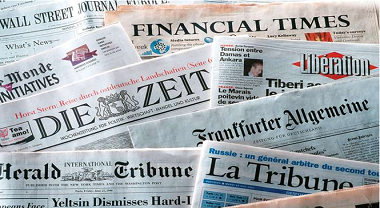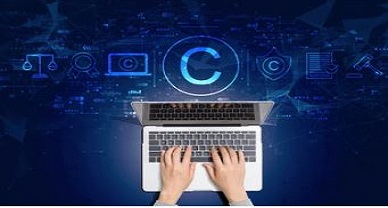The Ambit of Copyright Infringement in Forwarding E-Paper
The outbreak of this pandemic accompanied a lot of problems in day to day life. This pandemic has brought us into a new normal. This ‘new normal’ has its majority existence working through online platforms. One such area deeply affected by the present situation and hotly debated in recent times is the issues of e-newspaper. At various places, the disruption regarding physical disruption of the newspaper has seen an increase in the use of e-newspaper, mostly available on the official website of the newspaper. The larger question remains that whether the forwarding of e-paper constitutes copyright infringement, remains unanswered. Let us delve into this perspective.
[Image Source: https://www.britannica.com/topic/newspaper]
Copyright and IT Act
Every newspaper has its copyright over the content as it is their expression, the idea remains the same. Giving the argument of free speech and the public dissemination of news, which is by default the primary aim of the newspaper, cannot take over the copyright issues under this condition. The relatable confusion does arise over the interplay of the Copyright act 1957 and Information Technology act 2000. Many platforms talked about the liability of the Whatsapp group administrator in case there is the forwarding of content. There can be no dispute over such an aspect which is already been settled by the court. In Ashish Bhalla vs. Suresh Chawdhary (Ashish Bhalla v. Suresh Chawdhary, 2016 SCC Online Del 6329), the Delhi High Court ruled that the Whatsapp group administrator is not responsible for the content posted on the group by others. It was a welcome move by the Delhi HC, stating that no one can be held liable for something over which he or she has no control. This is similar to making a manufacturer of the newsprint, on which defamatory statements are published, liable for defamation, even if he or she has no hand in making that defamatory statement.
The arguments regarding the Information Technology (IT) act also does not hold good. Section 79 of the act talks about the exemption from liability of intermediary in certain cases, for any third party information, data, or communication. The intermediary in the present case is the social media platform on which the content is forwarded. If we read section 43, it talks about the penalty for damages that occur by accessing or even downloading data from the computer. On the other side, if we read section 66B, it also talks about the punishment for dishonestly receiving computer resources. But both the act supplements itself with the word, like ‘without permission’ or ‘dishonestly’. In neither case, the liability of the IT Act will apply to any of the members of the group, since even if the person downloads either freely or by accepting the terms, both instances can’t be termed as ‘dishonest practice’. But if we read proviso to section 81 of the act, it specifies that this act will not restrict any person from exercising any right under the copyright act or patents act, which ultimately gives ample scope to newspaper authorities to defend their arguments, leaving less scope for the IT act to interplay.
Talking about the copyright act, some sections can be very important for this discussion. Reading section 52(1) (a) (ii) & (iii) provides us with the exemption from infringing copyright if there is a fair deal of work for criticism and review or for reporting current events or current affairs. This way copyright does provide an exemption from the infringement process. The same section also provides other instances in favor of newspaper authority. Section 52(1)(c) says that transient and incidental storage or work to provide electronic links, access, or integration, where such links, access or integration ‘has not been expressly prohibited by the right holder’, will be exempted from copyright infringement. This section expressly mentions that the storage of work, for providing an electronic link, access or integration will be exempted from the infringement unless there has been an express prohibition by the right holder. Hence, this becomes crystal clear that if the e-papers come up with a disclaimer, agreeing to which it will be downloaded; section 52(1) (c) ceases to apply. The user will not get the benefit of section 52(1) (c). Nevertheless, the user can get the benefit of section 52(1)(a)(ii) &(iii), if it can be proved that this forwarding is for the very purpose of criticism or review, which seems impossible in all instances.
Implied License
Implied license doctrine, tries to give a just solution by allowing reasonable exploitation of the work by one party providing implicit consent for such use. Some arguments were also raised regarding the first sale doctrine applied in the present context. First sale doctrine, more precisely, the exhaustion of right doctrine works after the lawful copies of the work have been distributed by sale or other transfer. But the stark difference arises out of the limitation in the first sale doctrine which is generally limited only to dispose of the original copies, not allowing any other manipulation. Implied license, on the other hand, gives the right to use the copies of the work in a manner feasible, the consent is implied.
As soon as the user downloads the e-paper of any newspaper which already has a term of use, the implied license ceases to apply. The user can do anything except circulating it. But on the other side, if it becomes a freely downloadable copy, without any term of use, the implied license will act to the extent of even circulating it. This issue can be hotly debated as to what constitutes the ‘extent’ of implied license. However, in the present condition, this ‘extension’ is purely dependent upon the terms attached with the paper.
Author: Saransh Chaturvedi (an advocate) currently pursuing LLM from Rajiv Gandhi School of Intellectual Property Law (IIT Kharagpur). In case of any queries please contact/write back to us at support@ipandlegalfilings.com.




